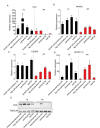Stearoyl-CoA Desaturase is Essential for Porcine Adipocyte Differentiation
- PMID: 32244800
- PMCID: PMC7177282
- DOI: 10.3390/ijms21072446
Stearoyl-CoA Desaturase is Essential for Porcine Adipocyte Differentiation
Abstract
Fat deposition, which influences pork production, meat quality and growth efficiency, is an economically important trait in pigs. Numerous studies have demonstrated that stearoyl-CoA desaturase (SCD), a key enzyme that catalyzes the conversion of saturated fatty acids into monounsaturated fatty acids, is associated with fatty acid composition in pigs. As SCD was observed to be significantly induced in 3T3-L1 preadipocytes differentiation, we hypothesized that it plays a role in porcine adipocyte differentiation and fat deposition. In this study, we revealed that SCD is highly expressed in adipose tissues from seven-day-old piglets, compared to its expression in tissues from four-month-old adult pigs. Moreover, we found that SCD and lipogenesis-related genes were induced significantly in differentiated porcine adipocytes. Using CRISPR/Cas9 technology, we generated SCD-/- porcine embryonic fibroblasts (PEFs) and found that the loss of SCD led to dramatically decreased transdifferentiation efficiency, as evidenced by the decreased expression of known lipid synthesis-related genes, lower levels of oil red O staining and significantly lower levels of triglyceride content. Our study demonstrates the critical role of SCD expression in porcine adipocyte differentiation and paves the way for identifying it as the promising candidate gene for less fat deposition in pigs.
Keywords: SCD; adipocytes; adipogenesis; transdifferentiation.
Conflict of interest statement
The authors declare no conflict of interest.
Figures




Similar articles
-
Suppression of adipocyte differentiation and lipid accumulation by stearidonic acid (SDA) in 3T3-L1 cells.Lipids Health Dis. 2017 Sep 25;16(1):181. doi: 10.1186/s12944-017-0574-7. Lipids Health Dis. 2017. PMID: 28946872 Free PMC article.
-
Inhibition of stearoyl-CoA desaturase-1 in differentiating 3T3-L1 preadipocytes upregulates elongase 6 and downregulates genes affecting triacylglycerol synthesis.Int J Obes (Lond). 2014 Nov;38(11):1449-56. doi: 10.1038/ijo.2014.35. Epub 2014 Feb 25. Int J Obes (Lond). 2014. PMID: 24566853
-
miR-199a-3p affects adipocytes differentiation and fatty acid composition through targeting SCD.Biochem Biophys Res Commun. 2017 Oct 7;492(1):82-88. doi: 10.1016/j.bbrc.2017.08.030. Epub 2017 Aug 10. Biochem Biophys Res Commun. 2017. PMID: 28803985
-
Regulation of stearoyl-CoA desaturase genes: role in cellular metabolism and preadipocyte differentiation.Biochem Biophys Res Commun. 1999 Dec 9;266(1):1-4. doi: 10.1006/bbrc.1999.1704. Biochem Biophys Res Commun. 1999. PMID: 10581155 Review.
-
The regulation of stearoyl-CoA desaturase (SCD).Prog Lipid Res. 1995;34(2):139-50. doi: 10.1016/0163-7827(94)00010-j. Prog Lipid Res. 1995. PMID: 7480063 Review.
Cited by
-
RNA-Seq Reveals Function of Bta-miR-149-5p in the Regulation of Bovine Adipocyte Differentiation.Animals (Basel). 2021 Apr 22;11(5):1207. doi: 10.3390/ani11051207. Animals (Basel). 2021. PMID: 33922274 Free PMC article.
-
Flavor, Lipid, and Transcriptomic Profiles of Chinese Wagyu Beef Cuts: Insights into Meat Quality Differences.Foods. 2025 Feb 20;14(5):716. doi: 10.3390/foods14050716. Foods. 2025. PMID: 40077419 Free PMC article.
-
Influence of Immunocastration and Diet on Meat and Fat Quality of Heavy Female and Male Pigs.Animals (Basel). 2021 Nov 24;11(12):3355. doi: 10.3390/ani11123355. Animals (Basel). 2021. PMID: 34944132 Free PMC article.
-
Probiotics Increase Intramuscular Fat and Improve the Composition of Fatty Acids in Sunit Sheep through the Adenosine 5'-Monophosphate-Activated Protein Kinase (AMPK) Signaling Pathway.Food Sci Anim Resour. 2023 Sep;43(5):805-825. doi: 10.5851/kosfa.2023.e37. Epub 2023 Sep 1. Food Sci Anim Resour. 2023. PMID: 37701743 Free PMC article.
-
Lipo-nutritional quality of pork: The lipid composition, regulation, and molecular mechanisms of fatty acid deposition.Anim Nutr. 2023 Mar 7;13:373-385. doi: 10.1016/j.aninu.2023.03.001. eCollection 2023 Jun. Anim Nutr. 2023. PMID: 37214214 Free PMC article.
References
-
- Zheng Q., Lin J., Huang J., Zhang H., Zhang R., Zhang X., Cao C., Hambly C., Qin G., Yao J. Reconstitution of UCP1 using CRISPR/Cas9 in the white adipose tissue of pigs decreases fat deposition and improves thermogenic capacity. Proc. Natl. Acad. Sci. USA. 2017;114:E9474. doi: 10.1073/pnas.1707853114. - DOI - PMC - PubMed
-
- Zhang Y., Zhang J., Gong H., Cui L., Zhang W., Ma J., Chen C., Ai H., Xiao S., Huang L., et al. Genetic correlation of fatty acid composition with growth, carcass, fat deposition and meat quality traits based on GWAS data in six pig populations. Meat Sci. 2019;150:47–55. doi: 10.1016/j.meatsci.2018.12.008. - DOI - PubMed
MeSH terms
Substances
Grants and funding
- 31672387/National Natural Science Foundation of China
- 31925036/National Natural Science Foundation of China
- 2016ZX08009003-006-007/National Transgenic Project of China
- poultrylab2019-5/Laboratory of Animal (Poultry) Genetics Breeding and Reproduction
- 2020-YWF-YB-04/Fundamental Research Funds for Central Public-interest Scientific Institution Basal Research Fund
LinkOut - more resources
Full Text Sources
Molecular Biology Databases
Research Materials

